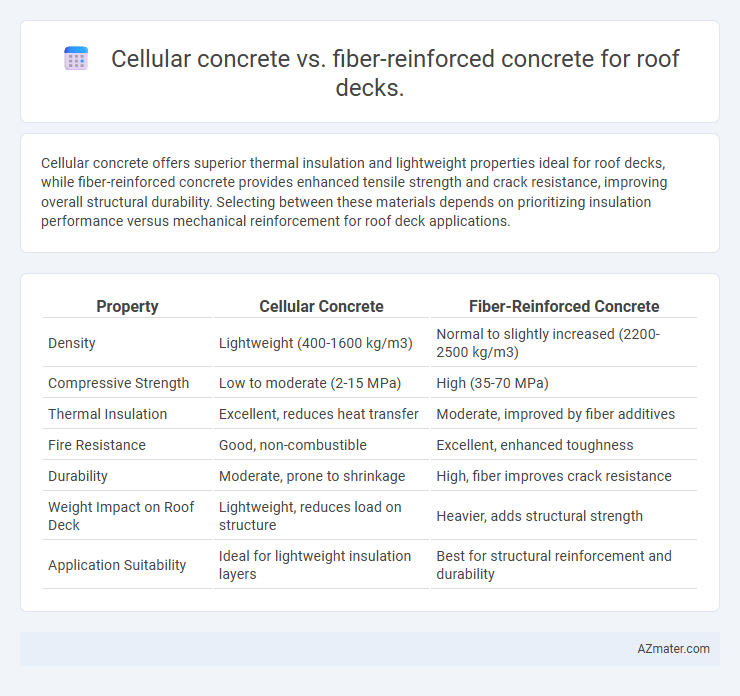Cellular concrete offers superior thermal insulation and lightweight properties ideal for roof decks, while fiber-reinforced concrete provides enhanced tensile strength and crack resistance, improving overall structural durability. Selecting between these materials depends on prioritizing insulation performance versus mechanical reinforcement for roof deck applications.
Table of Comparison
| Property | Cellular Concrete | Fiber-Reinforced Concrete |
|---|---|---|
| Density | Lightweight (400-1600 kg/m3) | Normal to slightly increased (2200-2500 kg/m3) |
| Compressive Strength | Low to moderate (2-15 MPa) | High (35-70 MPa) |
| Thermal Insulation | Excellent, reduces heat transfer | Moderate, improved by fiber additives |
| Fire Resistance | Good, non-combustible | Excellent, enhanced toughness |
| Durability | Moderate, prone to shrinkage | High, fiber improves crack resistance |
| Weight Impact on Roof Deck | Lightweight, reduces load on structure | Heavier, adds structural strength |
| Application Suitability | Ideal for lightweight insulation layers | Best for structural reinforcement and durability |
Introduction to Roof Deck Concrete Solutions
Cellular concrete offers lightweight and excellent thermal insulation properties ideal for roof deck applications, reducing structural load and improving energy efficiency. Fiber-reinforced concrete enhances tensile strength and crack resistance, providing durability and increased load-bearing capacity for roof decks. Selecting between cellular and fiber-reinforced concrete depends on balancing weight, structural requirements, thermal performance, and long-term durability.
Overview of Cellular Concrete
Cellular concrete is a lightweight, air-entrained material composed of cement, water, and foam, offering excellent thermal insulation and fire resistance properties. Its reduced density compared to traditional concrete makes it ideal for roof decks, reducing load on structural supports while maintaining sufficient compressive strength. The material's high void content provides superior sound absorption and energy efficiency, distinguishing it from fiber-reinforced concrete, which primarily enhances tensile strength and durability.
Overview of Fiber-Reinforced Concrete
Fiber-reinforced concrete (FRC) enhances the tensile strength, durability, and crack resistance of roof decks by incorporating synthetic or steel fibers within the concrete matrix. This composite material improves load-bearing capacity and impact resistance, making it ideal for withstanding structural stresses and environmental exposure. Compared to cellular concrete, FRC offers superior mechanical properties and reduced shrinkage, ensuring long-term performance in roofing applications.
Material Composition Differences
Cellular concrete consists of cement, water, and a foaming agent that creates air bubbles, resulting in a lightweight, porous structure ideal for roof decks requiring thermal insulation and reduced load. Fiber-reinforced concrete incorporates synthetic or steel fibers within a traditional concrete mix, enhancing tensile strength, impact resistance, and crack control for structural durability. The primary composition difference lies in cellular concrete's foamed matrix versus fiber-reinforced concrete's solid matrix reinforced with dispersed fibers.
Weight and Load-Bearing Capabilities
Cellular concrete offers a significantly lower density, typically ranging from 400 to 1600 kg/m3, making it ideal for lightweight roof decks where reducing structural load is critical. Fiber-reinforced concrete (FRC), with densities close to conventional concrete (around 2400 kg/m3), provides enhanced load-bearing capabilities and improved tensile strength due to fiber integration, supporting greater structural loads. Selecting between cellular concrete and FRC depends on balancing the need for minimizing dead load with ensuring adequate strength and durability for roof deck applications.
Thermal Insulation Performance
Cellular concrete offers superior thermal insulation for roof decks due to its lightweight, air-entrained structure that significantly reduces heat transfer. Fiber-reinforced concrete, while improving tensile strength and crack resistance, provides comparatively lower thermal insulation because of its denser matrix. Selecting cellular concrete enhances energy efficiency by minimizing heat loss and maintaining stable indoor temperatures in roofing applications.
Structural Strength and Durability
Cellular concrete offers lightweight properties with moderate compressive strength, making it suitable for non-load-bearing roof decks but less ideal where high structural strength is required. Fiber-reinforced concrete significantly enhances tensile strength, crack resistance, and overall durability, providing improved load-bearing capacity and longevity under dynamic roof deck stresses. The integration of fibers such as glass, steel, or synthetic materials in concrete matrices leads to superior resilience against environmental degradation and structural fatigue.
Installation Methods and Speed
Cellular concrete offers lightweight properties and can be easily poured or pumped into roof deck forms, resulting in faster installation times due to its fluid consistency and self-leveling capability. Fiber-reinforced concrete requires traditional placement and finishing techniques, involving more labor-intensive processes such as mixing, placing, and vibrating to ensure uniform fiber distribution and compaction. Consequently, cellular concrete typically enables quicker roof deck installations, reducing labor costs and project duration compared to fiber-reinforced concrete applications.
Cost Comparison: Cellular vs Fiber-Reinforced Concrete
Cellular concrete typically offers lower material and installation costs compared to fiber-reinforced concrete, making it a more budget-friendly option for roof decks. The lightweight nature of cellular concrete reduces structural load and associated expenses, while fiber-reinforced concrete requires higher-grade materials and specialized labor, increasing overall project costs. Maintenance and longevity factors also influence total cost, with fiber-reinforced concrete often providing enhanced durability that may offset initial investment over time.
Best Applications for Each Concrete Type in Roof Decks
Cellular concrete is ideal for roof decks requiring lightweight insulation with excellent thermal resistance and fireproofing properties, making it suitable for flat or low-slope roofs where reducing dead load is critical. Fiber-reinforced concrete enhances roof deck durability and impact resistance, especially in environments subjected to heavy loads, wind uplift, or potential cracking due to temperature variations. For optimal roof performance, cellular concrete is preferred in insulating and lightweight applications, whereas fiber-reinforced concrete is best for structural strength and crack control.

Infographic: Cellular concrete vs Fiber-reinforced concrete for Roof deck
 azmater.com
azmater.com